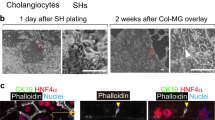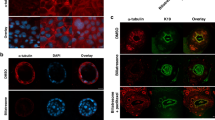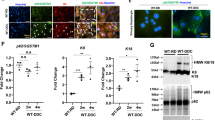Abstract
To investigate the hypothesis that during the development of biliary atresia, early changes in hepatobiliary transport are mainly related to the inflammatory process and lead to intrahepatic cholestasis and subsequent liver injury, livers from mice with rhesus rotavirus-induced biliary atresia were analyzed for mRNA expression of hepatobiliary transporters, nuclear receptors, and inflammatory cytokines. Seven days after inoculation, despite high bile acid concentrations in the liver, gene expression of canalicular and basolateral hepatobiliary transporters and their regulatory nuclear receptors was down-regulated with concomitant increase in gene expression of inflammatory cytokines and rise in serum unconjugated bilirubin. At 14 d, hepatobiliary transporters and nuclear receptors remained down-regulated although the inflammatory response subsided. The percentage of conjugated bilirubin started to increase as extrahepatic biliary obstruction occurred. At 18 d, expression of hepatobiliary transporters remained low, expression of nuclear receptors returned to normal, while expression of inflammatory cytokines decreased further. Moreover, histology demonstrated progressive inflammation, bile duct damage, ductular proliferation, and hepatocyte necrosis. In conclusion, intrahepatic cholestasis due to inflammation-related down-regulation of basolateral and canalicular hepatobiliary transporters is an early event in the development of biliary atresia. Intrahepatic cholestasis contributes to the development of jaundice and liver injury.
Similar content being viewed by others
Log in or create a free account to read this content
Gain free access to this article, as well as selected content from this journal and more on nature.com
or
Abbreviations
- BA:
-
biliary atresia
- BSEP:
-
bile salt export pump
- FXR:
-
farnesoid X receptor
- NTCP:
-
sodium-dependent taurocholate cotransporting polypeptide
- PXR:
-
pregnane X receptor
- RRV:
-
rhesus rotavirus
References
Geier A, Wagner M, Dietrich CG, Trauner M 2007 Principles of hepatic organic anion transporter regulation during cholestasis, inflammation, and liver regeneration. Biochim Biophys Acta 1773: 283–308
Jansen PL, Müller M 2000 The molecular genetics of familial intrahepatic cholestasis. Gut 47: 1–5
Jansen PL, Müller M, Sturm E 2001 Genes and cholestasis. Hepatology 34: 1067–1074
Trauner M, Fickert P, Zollner G 2001 Genetic disorders and molecular mechanisms in cholestatic liver disease—a clinical approach. Semin Gastrointest Dis 12: 66–88
Goodwin B, Jones SA, Price RR, Watson MA, McKee DD, Moore LB, Galardi C, Wilson JG, Lewis MC, Roth ME, Maloney PR, Willson TM, Kliewer SA 2000 A regulatory cascade of the nuclear receptors FXR, SHP-1, and LRH-1 represses bile acid biosynthesis. Mol Cell 6: 517–526
Lu TT, Makishima M, Repa JJ, Schoonjans K, Kerr TA, Auwerx J, Mangelsdorf DJ 2000 Molecular basis for feedback regulation of bile acid synthesis by nuclear receptors. Mol Cell 6: 507–515
Sinal CJ, Tohkin M, Miyata M, Ward JM, Lambert G, Gonzalez FJ 2000 Targeted disruption of the nuclear receptor FXR/BAR impairs bile acid and lipid homeostasis. Cell 102: 731–744
Petersen C, Kuske M, Bruns E, Biermanns D, Wussow PV, Mildenberger H 1998 Progress in developing animal models for biliary atresia. Eur J Pediatr Surg 8: 137–141
Petersen C, Grasshoff S, Luciano L 1998 Diverse morphology of biliary atresia in an animal model. J Hepatol 28: 603–607
Mack CL, Tucker RM, Sokol RJ, Karrer FM, Kotzin BL, Whitington PF, Miller SD 2004 Biliary atresia is associated with CD4+ Th1 cell-mediated portal tract inflammation. Pediatr Res 56: 79–87
Mack CL, Tucker RM, Sokol RJ, Kotzin BL 2005 Armed CD4+ Th1 effector cells and activated macrophages participate in bile duct injury in murine biliary atresia. Clin Immunol 115: 200–209
Mashige F, Imai K, Osuga T 1976 A simple and sensitive assay of total serum bile acids. Clin Chim Acta 70: 79–86
Lowry OH, Rosebrough NJ, Farr AL, Randall RJ 1951 Protein measurement with the Folin phenol reagent. J Biol Chem 193: 265–275
Stieger B, Hagenbuch B, Landmann L, Hochli M, Schroeder A, Meier PJ 1994 In situ localization of the hepatocytic Na+/Taurocholate cotransporting polypeptide in rat liver. Gastroenterology 107: 1781–1787
Vos TA, Hooiveld GJ, Koning H, Childs S, Meijer DK, Moshage H, Jansen PL, Muller M 1998 Up-regulation of the multidrug resistance genes, Mrp1 and Mdr1b, and down-regulation of the organic anion transporter, Mrp2, and the bile salt transporter, Spgp, in endotoxemic rat liver. Hepatology 28: 1637–1644
Gartung C, Ananthanarayanan M, Rahman MA, Schuele S, Nundy S, Soroka CJ, Stolz A, Suchy FJ, Boyer JL 1996 Down-regulation of expression and function of the rat liver Na+/bile acid cotransporter in extrahepatic cholestasis. Gastroenterology 110: 199–209
Dumont M, Jacquemin E, D'Hont C, Descout C, Cresteil D, Haouzi D, Desrochers M, Stieger B, Hadchouel M, Erlinger S 1997 Expression of the liver Na+-independent organic anion transporting polypeptide (oatp-1) in rats with bile duct ligation. J Hepatol 27: 1051–1056
Trauner M, Arrese M, Soroka CJ, Ananthanarayanan M, Koeppel TA, Schlosser SF, Suchy FJ, Keppler D, Boyer JL 1997 The rat canalicular conjugate export pump (Mrp2) is down-regulated in intrahepatic and obstructive cholestasis. Gastroenterology 113: 255–264
Lee JM, Trauner M, Soroka CJ, Stieger B, Meier PJ, Boyer JL 2000 Expression of the bile salt export pump is maintained after chronic cholestasis in the rat. Gastroenterology 118: 163–172
Cherrington NJ, Slitt AL, Li N, Klaassen CD 2004 Lipopolysaccharide-mediated regulation of hepatic transporter mRNA levels in rats. Drug Metab Dispos 32: 734–741
Geier A, Dietrich CG, Voigt S, Kim SK, Gerloff T, Kullak-Ublick GA, Lorenzen J, Matern S, Gartung C 2003 Effects of proinflammatory cytokines on rat organic anion transporters during toxic liver injury and cholestasis. Hepatology 38: 345–354
Green RM, Beier D, Gollan JL 1996 Regulation of hepatocyte bile salt transporters by endotoxin and inflammatory cytokines in rodents. Gastroenterology 111: 193–198
Hartmann G, Cheung AK, Piquette-Miller M 2002 Inflammatory cytokines, but not bile acids, regulate expression of murine hepatic anion transporters in endotoxemia. J Pharmacol Exp Ther 303: 273–281
Kim PK, Chen J, Andrejko KM, Deutschman CS 2000 Intraabdominal sepsis down-regulates transcription of sodium taurocholate cotransporter and multidrug resistance-associated protein in rats. Shock 14: 176–181
Lund M, Kang L, Tygstrup N, Wolkoff AW, Ott P 1999 Effects of LPS on transport of indocyanine green and alanine uptake in perfused rat liver. Am J Physiol 277: G91–G100
Trauner M, Arrese M, Lee H, Boyer JL, Karpen SJ 1998 Endotoxin downregulates rat hepatic ntcp gene expression via decreased activity of critical transcription factors. J Clin Invest 101: 2092–2100
Teng S, Piquette-Miller M 2008 Regulation of transporters by nuclear hormone receptors: implications during inflammation. Mol Pharm 5: 67–76
Siewert E, Dietrich CG, Lammert F, Heinrich PC, Matern S, Gartung C, Geier A 2004 Interleukin-6 regulates hepatic transporters during acute-phase response. Biochem Biophys Res Commun 322: 232–238
Shneider BL, Fox VL, Schwarz KB, Watson CL, Ananthanarayanan M, Thevananther S, Christie DM, Hardikar W, Setchell KD, Mieli-Vergani G, Suchy FJ, Mowat AP 1997 Hepatic basolateral sodium-dependent-bile acid transporter expression in two unusual cases of hypercholanemia and in extrahepatic biliary atresia. Hepatology 25: 1176–1183
Chen HL, Liu YJ, Chen HL, Wu SH, Ni YH, Ho MC, Lai HS, Hsu WM, Hsu HY, Tseng HC, Jeng YM, Chang MH 2008 Expression of hepatocyte transporters and nuclear receptors in children with early and late-stage biliary atresia. Pediatr Res 63: 667–673
Donner MG, Schumacher S, Warskulat U, Heinemann J, Haussinger D 2007 Periportal downregulation of Bsep and Mrp2 in experimental obstructive cholestasis is mediated by tnf-alpha and IL1-beta and is associated with periportal inflammation and cytokine secretion. J Hepatol 46: S120–S121
Eloranta JJ, Jung D, Kullak-Ublick GA 2006 The human Na+-taurocholate cotransporting polypeptide gene is activated by glucocorticoid receptor and peroxisome proliferator-activated receptor-gamma coactivator-1alpha, and suppressed by bile acids via a small heterodimer partner-dependent mechanism. Mol Endocrinol 20: 65–79
Shivakumar P, Campbell KM, Sabla GE, Miethke A, Tiao G, McNeal MM, Ward RL, Bezerra JA 2004 Obstruction of extrahepatic bile ducts by lymphocytes is regulated by IFN-gamma in experimental biliary atresia. J Clin Invest 114: 322–329
Acknowledgements
We thank Professor Claus Petersen and Joachim Kuebler, Department of Pediatric Surgery, Hannover Medical School, Hannover, Germany, for the provision of the rhesus rotavirus and support for setting up the murine biliary atresia model; and Tineke van der Sluis, Department of Pathology, Frans Stellaard, Renze Boverhof, and Henk Wolters, Pediatric Research Laboratory, University Medical Center Groningen, for technical assistance and research support.
Author information
Authors and Affiliations
Corresponding author
Additional information
Supported by a Gastrostart grant from The Netherlands Society of Gastroenterology and a grant from the Jan Kornelis de Cock Foundation.
Rights and permissions
About this article
Cite this article
Yang, H., Plösch, T., Lisman, T. et al. Inflammation Mediated Down-Regulation of Hepatobiliary Transporters Contributes to Intrahepatic Cholestasis and Liver Damage in Murine Biliary Atresia. Pediatr Res 66, 380–385 (2009). https://doi.org/10.1203/PDR.0b013e3181b454a4
Received:
Accepted:
Issue date:
DOI: https://doi.org/10.1203/PDR.0b013e3181b454a4



